Taxation Report
VerifiedAdded on 2020/02/05
|19
|5319
|27
Report
AI Summary
This report provides a comprehensive overview of the UK tax environment, including a description of the system, the roles and responsibilities of tax practitioners, and the implications of non-compliance. It then delves into practical calculations, demonstrating how to calculate relevant income, expenses, and allowances for both employment and self-employment scenarios. Specific examples are provided, including calculations for taxable amounts, capital gains tax, and chargeable profits for a company. The report also details the necessary documentation (P45, P60, P11D forms) required for tax filings and explains the deductions allowed for lease premiums and plant and machinery. The conclusion summarizes the UK's relatively straightforward tax system and highlights the importance of accurate reporting and compliance.
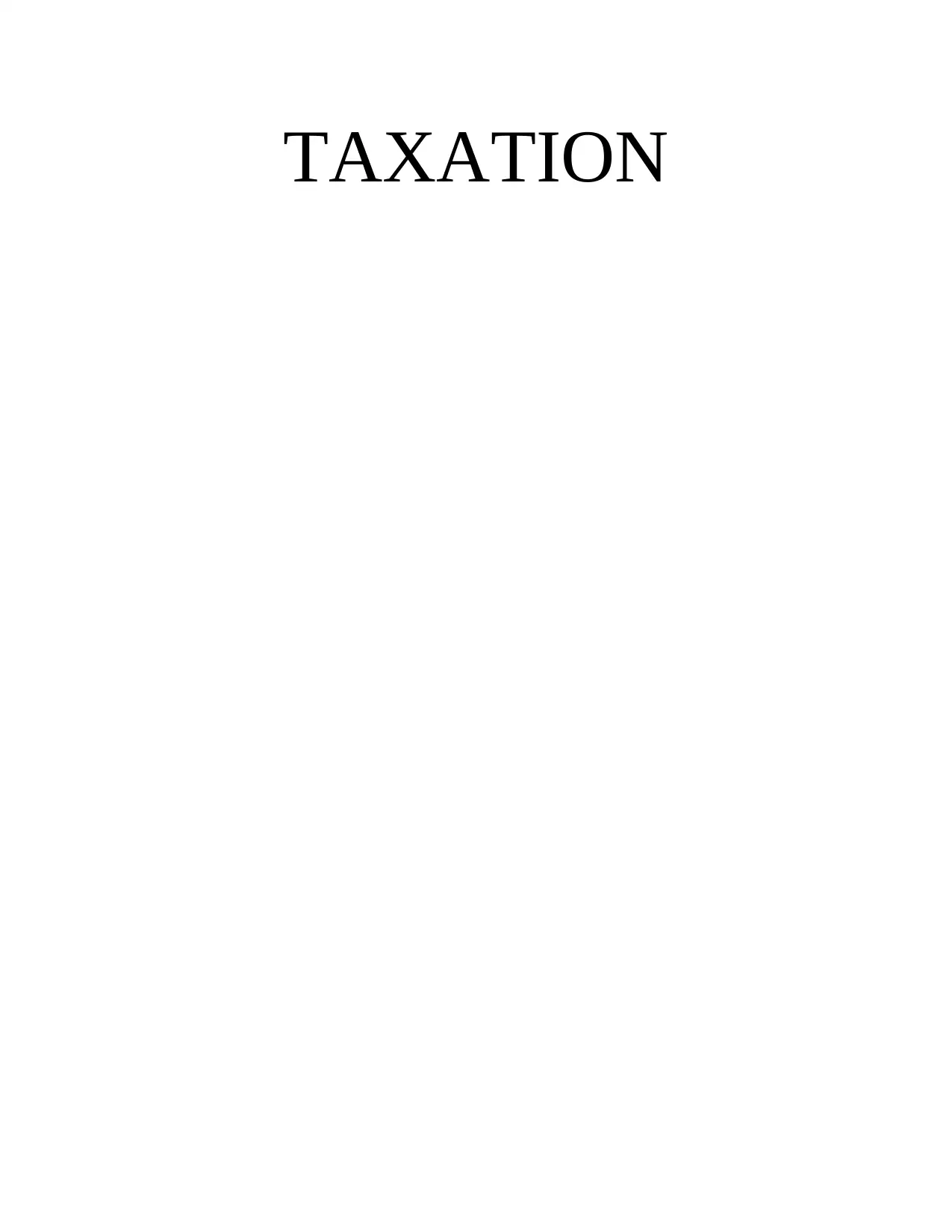
TAXATION
Paraphrase This Document
Need a fresh take? Get an instant paraphrase of this document with our AI Paraphraser
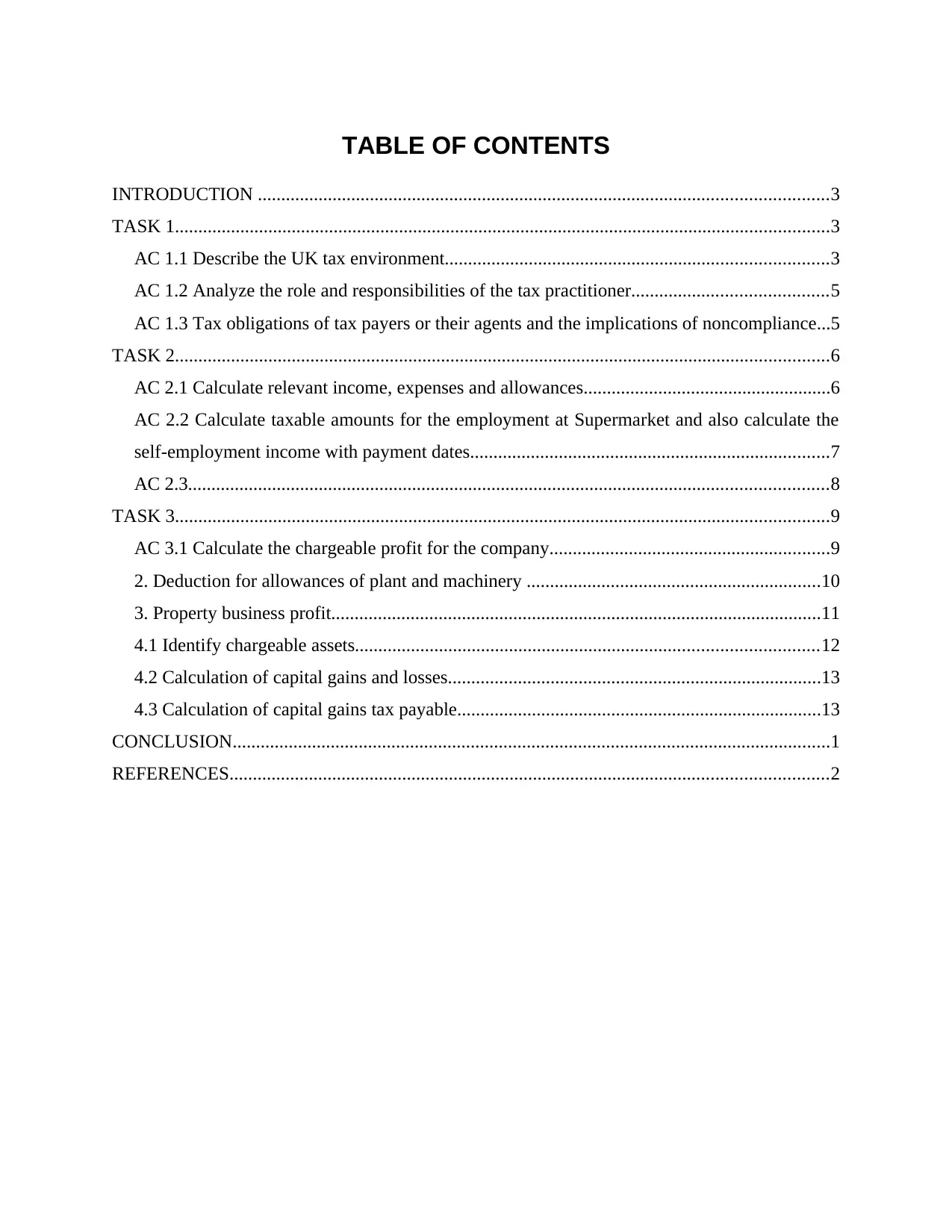
TABLE OF CONTENTS
INTRODUCTION ..........................................................................................................................3
TASK 1............................................................................................................................................3
AC 1.1 Describe the UK tax environment..................................................................................3
AC 1.2 Analyze the role and responsibilities of the tax practitioner..........................................5
AC 1.3 Tax obligations of tax payers or their agents and the implications of noncompliance...5
TASK 2............................................................................................................................................6
AC 2.1 Calculate relevant income, expenses and allowances.....................................................6
AC 2.2 Calculate taxable amounts for the employment at Supermarket and also calculate the
self-employment income with payment dates.............................................................................7
AC 2.3.........................................................................................................................................8
TASK 3............................................................................................................................................9
AC 3.1 Calculate the chargeable profit for the company............................................................9
2. Deduction for allowances of plant and machinery ...............................................................10
3. Property business profit.........................................................................................................11
4.1 Identify chargeable assets...................................................................................................12
4.2 Calculation of capital gains and losses................................................................................13
4.3 Calculation of capital gains tax payable..............................................................................13
CONCLUSION................................................................................................................................1
REFERENCES................................................................................................................................2
INTRODUCTION ..........................................................................................................................3
TASK 1............................................................................................................................................3
AC 1.1 Describe the UK tax environment..................................................................................3
AC 1.2 Analyze the role and responsibilities of the tax practitioner..........................................5
AC 1.3 Tax obligations of tax payers or their agents and the implications of noncompliance...5
TASK 2............................................................................................................................................6
AC 2.1 Calculate relevant income, expenses and allowances.....................................................6
AC 2.2 Calculate taxable amounts for the employment at Supermarket and also calculate the
self-employment income with payment dates.............................................................................7
AC 2.3.........................................................................................................................................8
TASK 3............................................................................................................................................9
AC 3.1 Calculate the chargeable profit for the company............................................................9
2. Deduction for allowances of plant and machinery ...............................................................10
3. Property business profit.........................................................................................................11
4.1 Identify chargeable assets...................................................................................................12
4.2 Calculation of capital gains and losses................................................................................13
4.3 Calculation of capital gains tax payable..............................................................................13
CONCLUSION................................................................................................................................1
REFERENCES................................................................................................................................2
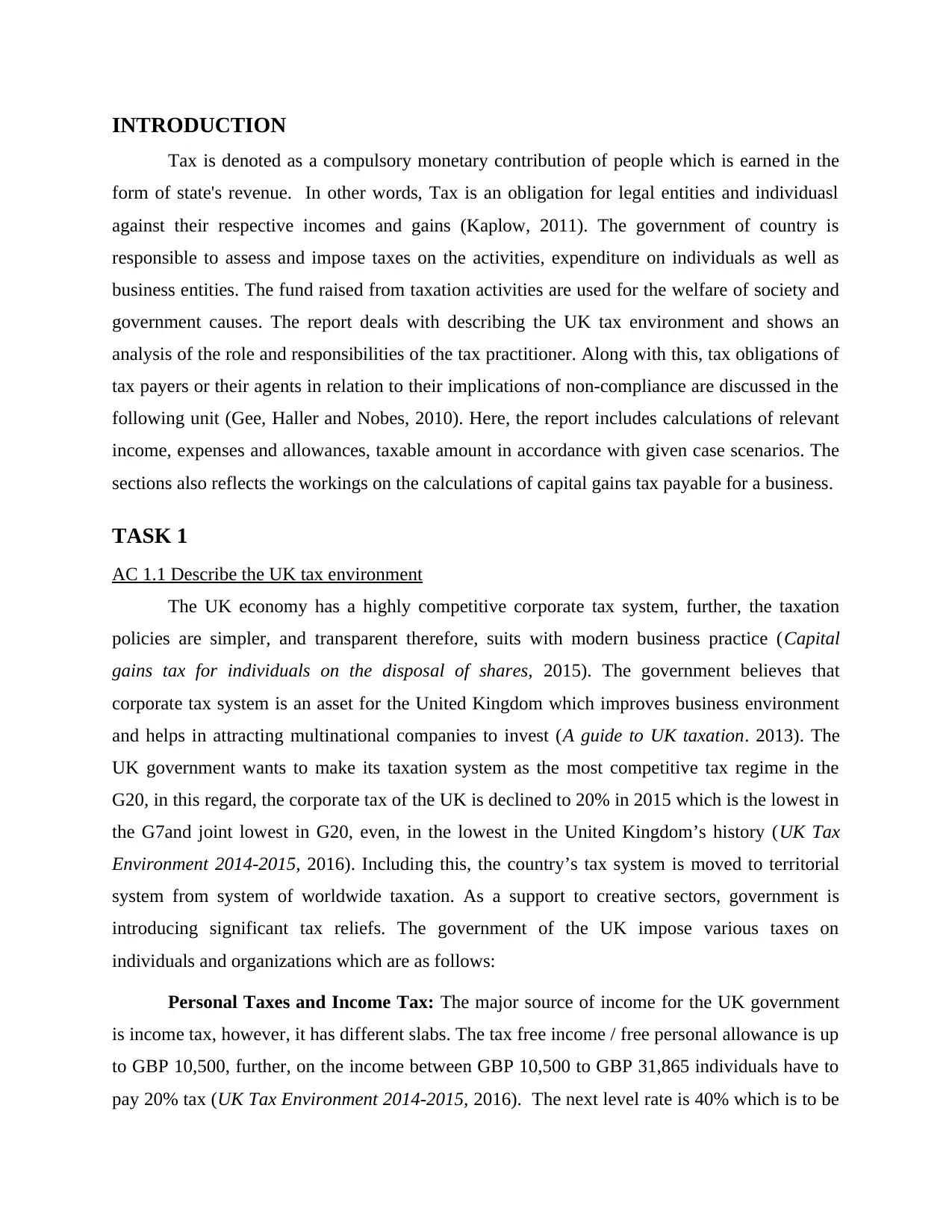
INTRODUCTION
Tax is denoted as a compulsory monetary contribution of people which is earned in the
form of state's revenue. In other words, Tax is an obligation for legal entities and individuasl
against their respective incomes and gains (Kaplow, 2011). The government of country is
responsible to assess and impose taxes on the activities, expenditure on individuals as well as
business entities. The fund raised from taxation activities are used for the welfare of society and
government causes. The report deals with describing the UK tax environment and shows an
analysis of the role and responsibilities of the tax practitioner. Along with this, tax obligations of
tax payers or their agents in relation to their implications of non-compliance are discussed in the
following unit (Gee, Haller and Nobes, 2010). Here, the report includes calculations of relevant
income, expenses and allowances, taxable amount in accordance with given case scenarios. The
sections also reflects the workings on the calculations of capital gains tax payable for a business.
TASK 1
AC 1.1 Describe the UK tax environment
The UK economy has a highly competitive corporate tax system, further, the taxation
policies are simpler, and transparent therefore, suits with modern business practice (Capital
gains tax for individuals on the disposal of shares, 2015). The government believes that
corporate tax system is an asset for the United Kingdom which improves business environment
and helps in attracting multinational companies to invest (A guide to UK taxation. 2013). The
UK government wants to make its taxation system as the most competitive tax regime in the
G20, in this regard, the corporate tax of the UK is declined to 20% in 2015 which is the lowest in
the G7and joint lowest in G20, even, in the lowest in the United Kingdom’s history (UK Tax
Environment 2014-2015, 2016). Including this, the country’s tax system is moved to territorial
system from system of worldwide taxation. As a support to creative sectors, government is
introducing significant tax reliefs. The government of the UK impose various taxes on
individuals and organizations which are as follows:
Personal Taxes and Income Tax: The major source of income for the UK government
is income tax, however, it has different slabs. The tax free income / free personal allowance is up
to GBP 10,500, further, on the income between GBP 10,500 to GBP 31,865 individuals have to
pay 20% tax (UK Tax Environment 2014-2015, 2016). The next level rate is 40% which is to be
Tax is denoted as a compulsory monetary contribution of people which is earned in the
form of state's revenue. In other words, Tax is an obligation for legal entities and individuasl
against their respective incomes and gains (Kaplow, 2011). The government of country is
responsible to assess and impose taxes on the activities, expenditure on individuals as well as
business entities. The fund raised from taxation activities are used for the welfare of society and
government causes. The report deals with describing the UK tax environment and shows an
analysis of the role and responsibilities of the tax practitioner. Along with this, tax obligations of
tax payers or their agents in relation to their implications of non-compliance are discussed in the
following unit (Gee, Haller and Nobes, 2010). Here, the report includes calculations of relevant
income, expenses and allowances, taxable amount in accordance with given case scenarios. The
sections also reflects the workings on the calculations of capital gains tax payable for a business.
TASK 1
AC 1.1 Describe the UK tax environment
The UK economy has a highly competitive corporate tax system, further, the taxation
policies are simpler, and transparent therefore, suits with modern business practice (Capital
gains tax for individuals on the disposal of shares, 2015). The government believes that
corporate tax system is an asset for the United Kingdom which improves business environment
and helps in attracting multinational companies to invest (A guide to UK taxation. 2013). The
UK government wants to make its taxation system as the most competitive tax regime in the
G20, in this regard, the corporate tax of the UK is declined to 20% in 2015 which is the lowest in
the G7and joint lowest in G20, even, in the lowest in the United Kingdom’s history (UK Tax
Environment 2014-2015, 2016). Including this, the country’s tax system is moved to territorial
system from system of worldwide taxation. As a support to creative sectors, government is
introducing significant tax reliefs. The government of the UK impose various taxes on
individuals and organizations which are as follows:
Personal Taxes and Income Tax: The major source of income for the UK government
is income tax, however, it has different slabs. The tax free income / free personal allowance is up
to GBP 10,500, further, on the income between GBP 10,500 to GBP 31,865 individuals have to
pay 20% tax (UK Tax Environment 2014-2015, 2016). The next level rate is 40% which is to be
⊘ This is a preview!⊘
Do you want full access?
Subscribe today to unlock all pages.

Trusted by 1+ million students worldwide
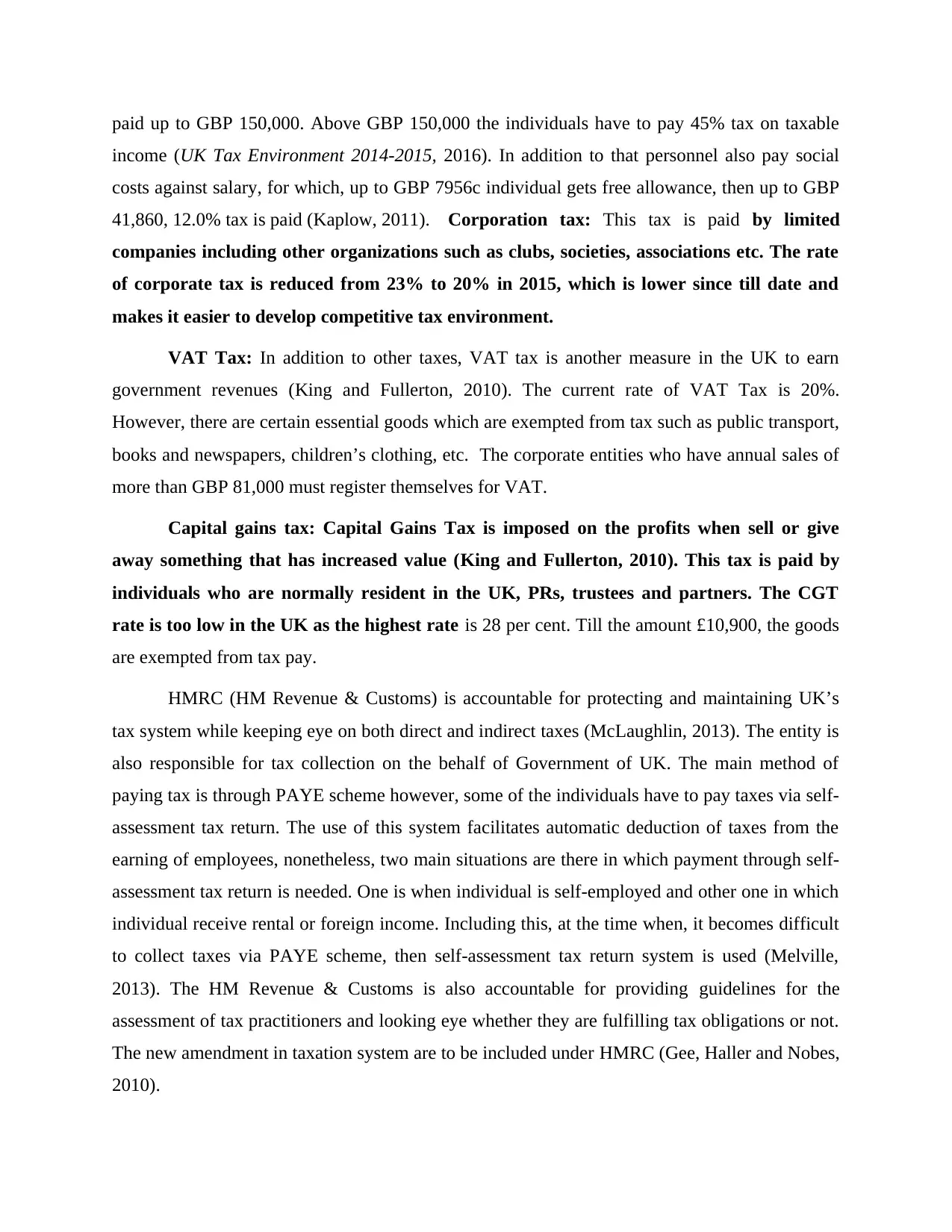
paid up to GBP 150,000. Above GBP 150,000 the individuals have to pay 45% tax on taxable
income (UK Tax Environment 2014-2015, 2016). In addition to that personnel also pay social
costs against salary, for which, up to GBP 7956c individual gets free allowance, then up to GBP
41,860, 12.0% tax is paid (Kaplow, 2011). Corporation tax: This tax is paid by limited
companies including other organizations such as clubs, societies, associations etc. The rate
of corporate tax is reduced from 23% to 20% in 2015, which is lower since till date and
makes it easier to develop competitive tax environment.
VAT Tax: In addition to other taxes, VAT tax is another measure in the UK to earn
government revenues (King and Fullerton, 2010). The current rate of VAT Tax is 20%.
However, there are certain essential goods which are exempted from tax such as public transport,
books and newspapers, children’s clothing, etc. The corporate entities who have annual sales of
more than GBP 81,000 must register themselves for VAT.
Capital gains tax: Capital Gains Tax is imposed on the profits when sell or give
away something that has increased value (King and Fullerton, 2010). This tax is paid by
individuals who are normally resident in the UK, PRs, trustees and partners. The CGT
rate is too low in the UK as the highest rate is 28 per cent. Till the amount £10,900, the goods
are exempted from tax pay.
HMRC (HM Revenue & Customs) is accountable for protecting and maintaining UK’s
tax system while keeping eye on both direct and indirect taxes (McLaughlin, 2013). The entity is
also responsible for tax collection on the behalf of Government of UK. The main method of
paying tax is through PAYE scheme however, some of the individuals have to pay taxes via self-
assessment tax return. The use of this system facilitates automatic deduction of taxes from the
earning of employees, nonetheless, two main situations are there in which payment through self-
assessment tax return is needed. One is when individual is self-employed and other one in which
individual receive rental or foreign income. Including this, at the time when, it becomes difficult
to collect taxes via PAYE scheme, then self-assessment tax return system is used (Melville,
2013). The HM Revenue & Customs is also accountable for providing guidelines for the
assessment of tax practitioners and looking eye whether they are fulfilling tax obligations or not.
The new amendment in taxation system are to be included under HMRC (Gee, Haller and Nobes,
2010).
income (UK Tax Environment 2014-2015, 2016). In addition to that personnel also pay social
costs against salary, for which, up to GBP 7956c individual gets free allowance, then up to GBP
41,860, 12.0% tax is paid (Kaplow, 2011). Corporation tax: This tax is paid by limited
companies including other organizations such as clubs, societies, associations etc. The rate
of corporate tax is reduced from 23% to 20% in 2015, which is lower since till date and
makes it easier to develop competitive tax environment.
VAT Tax: In addition to other taxes, VAT tax is another measure in the UK to earn
government revenues (King and Fullerton, 2010). The current rate of VAT Tax is 20%.
However, there are certain essential goods which are exempted from tax such as public transport,
books and newspapers, children’s clothing, etc. The corporate entities who have annual sales of
more than GBP 81,000 must register themselves for VAT.
Capital gains tax: Capital Gains Tax is imposed on the profits when sell or give
away something that has increased value (King and Fullerton, 2010). This tax is paid by
individuals who are normally resident in the UK, PRs, trustees and partners. The CGT
rate is too low in the UK as the highest rate is 28 per cent. Till the amount £10,900, the goods
are exempted from tax pay.
HMRC (HM Revenue & Customs) is accountable for protecting and maintaining UK’s
tax system while keeping eye on both direct and indirect taxes (McLaughlin, 2013). The entity is
also responsible for tax collection on the behalf of Government of UK. The main method of
paying tax is through PAYE scheme however, some of the individuals have to pay taxes via self-
assessment tax return. The use of this system facilitates automatic deduction of taxes from the
earning of employees, nonetheless, two main situations are there in which payment through self-
assessment tax return is needed. One is when individual is self-employed and other one in which
individual receive rental or foreign income. Including this, at the time when, it becomes difficult
to collect taxes via PAYE scheme, then self-assessment tax return system is used (Melville,
2013). The HM Revenue & Customs is also accountable for providing guidelines for the
assessment of tax practitioners and looking eye whether they are fulfilling tax obligations or not.
The new amendment in taxation system are to be included under HMRC (Gee, Haller and Nobes,
2010).
Paraphrase This Document
Need a fresh take? Get an instant paraphrase of this document with our AI Paraphraser
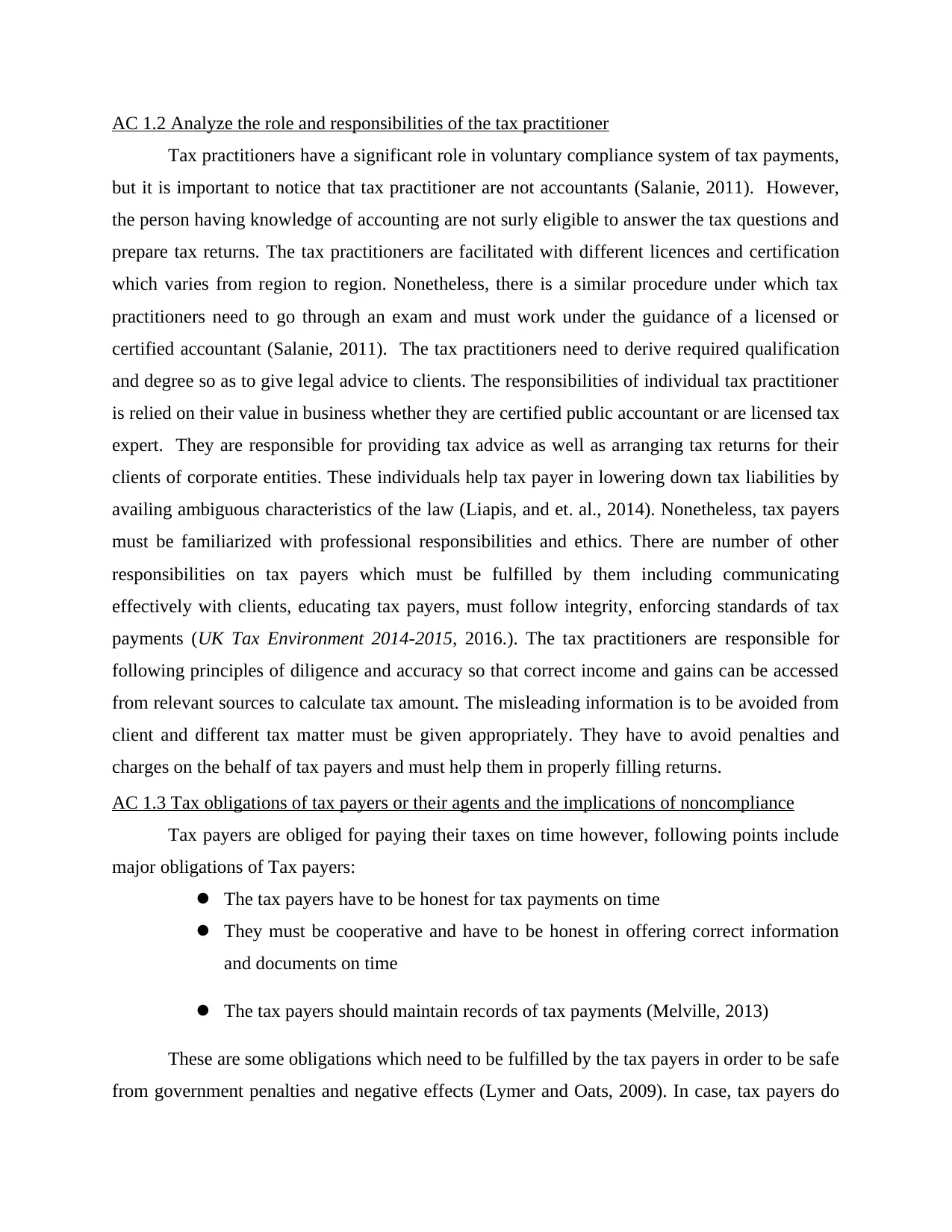
AC 1.2 Analyze the role and responsibilities of the tax practitioner
Tax practitioners have a significant role in voluntary compliance system of tax payments,
but it is important to notice that tax practitioner are not accountants (Salanie, 2011). However,
the person having knowledge of accounting are not surly eligible to answer the tax questions and
prepare tax returns. The tax practitioners are facilitated with different licences and certification
which varies from region to region. Nonetheless, there is a similar procedure under which tax
practitioners need to go through an exam and must work under the guidance of a licensed or
certified accountant (Salanie, 2011). The tax practitioners need to derive required qualification
and degree so as to give legal advice to clients. The responsibilities of individual tax practitioner
is relied on their value in business whether they are certified public accountant or are licensed tax
expert. They are responsible for providing tax advice as well as arranging tax returns for their
clients of corporate entities. These individuals help tax payer in lowering down tax liabilities by
availing ambiguous characteristics of the law (Liapis, and et. al., 2014). Nonetheless, tax payers
must be familiarized with professional responsibilities and ethics. There are number of other
responsibilities on tax payers which must be fulfilled by them including communicating
effectively with clients, educating tax payers, must follow integrity, enforcing standards of tax
payments (UK Tax Environment 2014-2015, 2016.). The tax practitioners are responsible for
following principles of diligence and accuracy so that correct income and gains can be accessed
from relevant sources to calculate tax amount. The misleading information is to be avoided from
client and different tax matter must be given appropriately. They have to avoid penalties and
charges on the behalf of tax payers and must help them in properly filling returns.
AC 1.3 Tax obligations of tax payers or their agents and the implications of noncompliance
Tax payers are obliged for paying their taxes on time however, following points include
major obligations of Tax payers:
l The tax payers have to be honest for tax payments on time
l They must be cooperative and have to be honest in offering correct information
and documents on time
l The tax payers should maintain records of tax payments (Melville, 2013)
These are some obligations which need to be fulfilled by the tax payers in order to be safe
from government penalties and negative effects (Lymer and Oats, 2009). In case, tax payers do
Tax practitioners have a significant role in voluntary compliance system of tax payments,
but it is important to notice that tax practitioner are not accountants (Salanie, 2011). However,
the person having knowledge of accounting are not surly eligible to answer the tax questions and
prepare tax returns. The tax practitioners are facilitated with different licences and certification
which varies from region to region. Nonetheless, there is a similar procedure under which tax
practitioners need to go through an exam and must work under the guidance of a licensed or
certified accountant (Salanie, 2011). The tax practitioners need to derive required qualification
and degree so as to give legal advice to clients. The responsibilities of individual tax practitioner
is relied on their value in business whether they are certified public accountant or are licensed tax
expert. They are responsible for providing tax advice as well as arranging tax returns for their
clients of corporate entities. These individuals help tax payer in lowering down tax liabilities by
availing ambiguous characteristics of the law (Liapis, and et. al., 2014). Nonetheless, tax payers
must be familiarized with professional responsibilities and ethics. There are number of other
responsibilities on tax payers which must be fulfilled by them including communicating
effectively with clients, educating tax payers, must follow integrity, enforcing standards of tax
payments (UK Tax Environment 2014-2015, 2016.). The tax practitioners are responsible for
following principles of diligence and accuracy so that correct income and gains can be accessed
from relevant sources to calculate tax amount. The misleading information is to be avoided from
client and different tax matter must be given appropriately. They have to avoid penalties and
charges on the behalf of tax payers and must help them in properly filling returns.
AC 1.3 Tax obligations of tax payers or their agents and the implications of noncompliance
Tax payers are obliged for paying their taxes on time however, following points include
major obligations of Tax payers:
l The tax payers have to be honest for tax payments on time
l They must be cooperative and have to be honest in offering correct information
and documents on time
l The tax payers should maintain records of tax payments (Melville, 2013)
These are some obligations which need to be fulfilled by the tax payers in order to be safe
from government penalties and negative effects (Lymer and Oats, 2009). In case, tax payers do
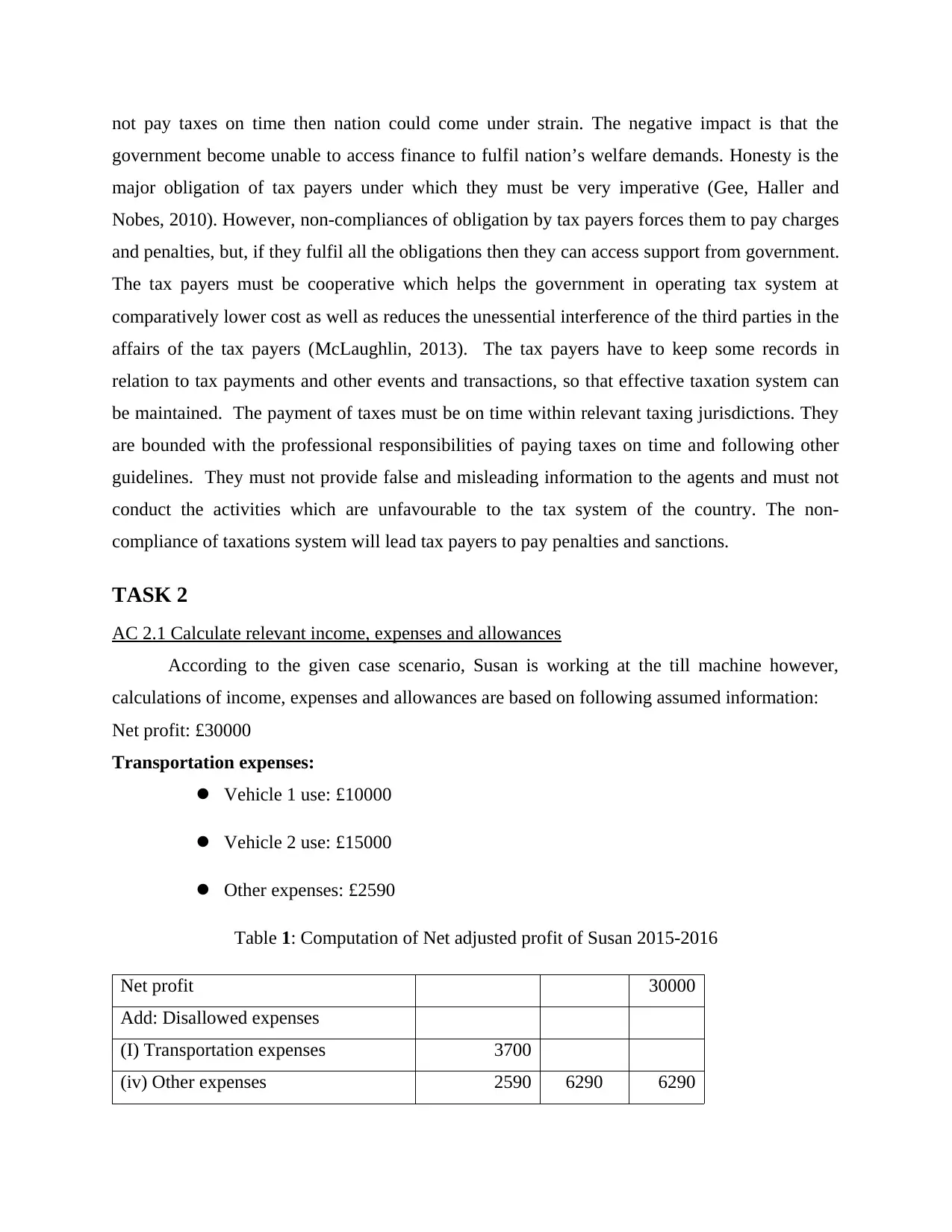
not pay taxes on time then nation could come under strain. The negative impact is that the
government become unable to access finance to fulfil nation’s welfare demands. Honesty is the
major obligation of tax payers under which they must be very imperative (Gee, Haller and
Nobes, 2010). However, non-compliances of obligation by tax payers forces them to pay charges
and penalties, but, if they fulfil all the obligations then they can access support from government.
The tax payers must be cooperative which helps the government in operating tax system at
comparatively lower cost as well as reduces the unessential interference of the third parties in the
affairs of the tax payers (McLaughlin, 2013). The tax payers have to keep some records in
relation to tax payments and other events and transactions, so that effective taxation system can
be maintained. The payment of taxes must be on time within relevant taxing jurisdictions. They
are bounded with the professional responsibilities of paying taxes on time and following other
guidelines. They must not provide false and misleading information to the agents and must not
conduct the activities which are unfavourable to the tax system of the country. The non-
compliance of taxations system will lead tax payers to pay penalties and sanctions.
TASK 2
AC 2.1 Calculate relevant income, expenses and allowances
According to the given case scenario, Susan is working at the till machine however,
calculations of income, expenses and allowances are based on following assumed information:
Net profit: £30000
Transportation expenses:
l Vehicle 1 use: £10000
l Vehicle 2 use: £15000
l Other expenses: £2590
Table 1: Computation of Net adjusted profit of Susan 2015-2016
Net profit 30000
Add: Disallowed expenses
(I) Transportation expenses 3700
(iv) Other expenses 2590 6290 6290
government become unable to access finance to fulfil nation’s welfare demands. Honesty is the
major obligation of tax payers under which they must be very imperative (Gee, Haller and
Nobes, 2010). However, non-compliances of obligation by tax payers forces them to pay charges
and penalties, but, if they fulfil all the obligations then they can access support from government.
The tax payers must be cooperative which helps the government in operating tax system at
comparatively lower cost as well as reduces the unessential interference of the third parties in the
affairs of the tax payers (McLaughlin, 2013). The tax payers have to keep some records in
relation to tax payments and other events and transactions, so that effective taxation system can
be maintained. The payment of taxes must be on time within relevant taxing jurisdictions. They
are bounded with the professional responsibilities of paying taxes on time and following other
guidelines. They must not provide false and misleading information to the agents and must not
conduct the activities which are unfavourable to the tax system of the country. The non-
compliance of taxations system will lead tax payers to pay penalties and sanctions.
TASK 2
AC 2.1 Calculate relevant income, expenses and allowances
According to the given case scenario, Susan is working at the till machine however,
calculations of income, expenses and allowances are based on following assumed information:
Net profit: £30000
Transportation expenses:
l Vehicle 1 use: £10000
l Vehicle 2 use: £15000
l Other expenses: £2590
Table 1: Computation of Net adjusted profit of Susan 2015-2016
Net profit 30000
Add: Disallowed expenses
(I) Transportation expenses 3700
(iv) Other expenses 2590 6290 6290
⊘ This is a preview!⊘
Do you want full access?
Subscribe today to unlock all pages.

Trusted by 1+ million students worldwide
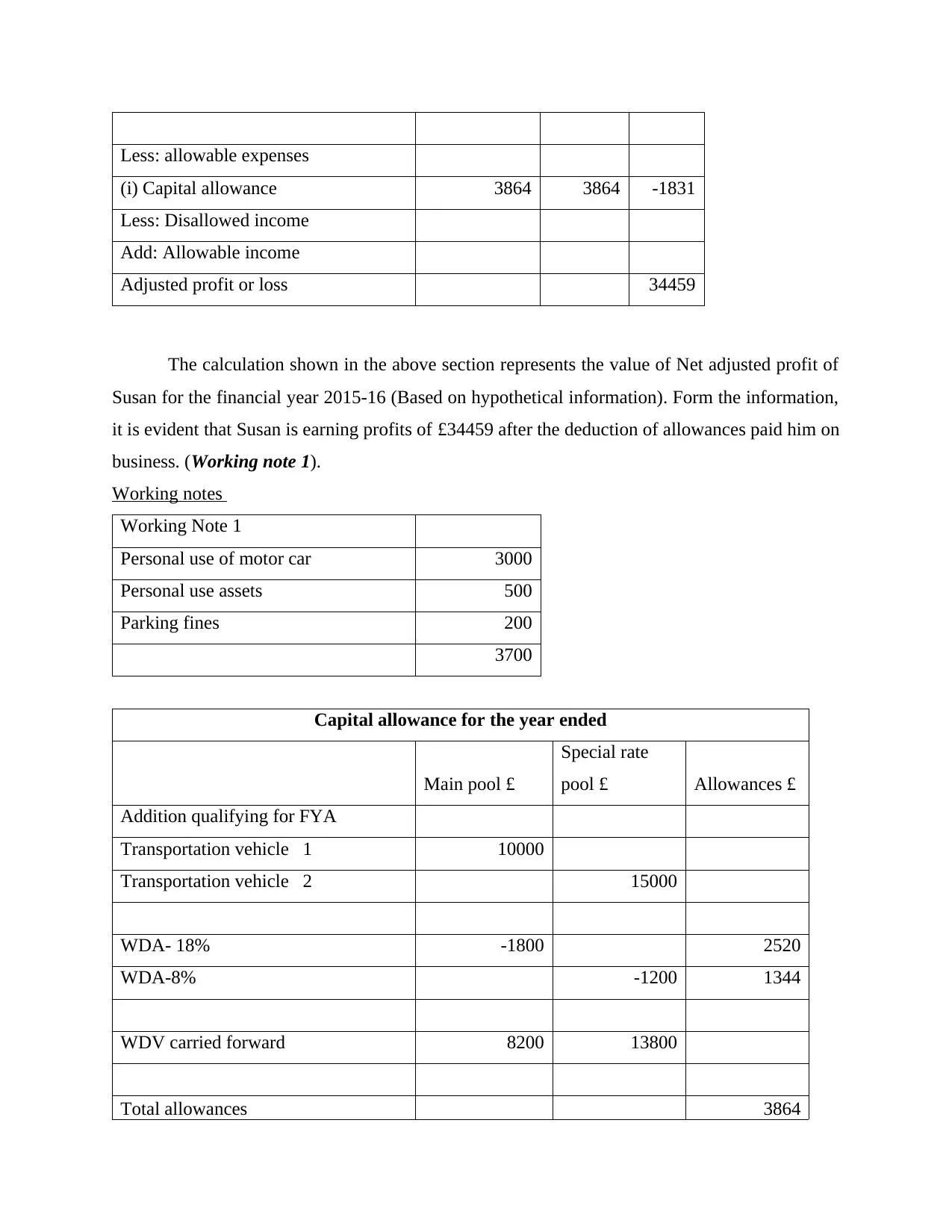
Less: allowable expenses
(i) Capital allowance 3864 3864 -1831
Less: Disallowed income
Add: Allowable income
Adjusted profit or loss 34459
The calculation shown in the above section represents the value of Net adjusted profit of
Susan for the financial year 2015-16 (Based on hypothetical information). Form the information,
it is evident that Susan is earning profits of £34459 after the deduction of allowances paid him on
business. (Working note 1).
Working notes
Working Note 1
Personal use of motor car 3000
Personal use assets 500
Parking fines 200
3700
Capital allowance for the year ended
Main pool £
Special rate
pool £ Allowances £
Addition qualifying for FYA
Transportation vehicle 1 10000
Transportation vehicle 2 15000
WDA- 18% -1800 2520
WDA-8% -1200 1344
WDV carried forward 8200 13800
Total allowances 3864
(i) Capital allowance 3864 3864 -1831
Less: Disallowed income
Add: Allowable income
Adjusted profit or loss 34459
The calculation shown in the above section represents the value of Net adjusted profit of
Susan for the financial year 2015-16 (Based on hypothetical information). Form the information,
it is evident that Susan is earning profits of £34459 after the deduction of allowances paid him on
business. (Working note 1).
Working notes
Working Note 1
Personal use of motor car 3000
Personal use assets 500
Parking fines 200
3700
Capital allowance for the year ended
Main pool £
Special rate
pool £ Allowances £
Addition qualifying for FYA
Transportation vehicle 1 10000
Transportation vehicle 2 15000
WDA- 18% -1800 2520
WDA-8% -1200 1344
WDV carried forward 8200 13800
Total allowances 3864
Paraphrase This Document
Need a fresh take? Get an instant paraphrase of this document with our AI Paraphraser
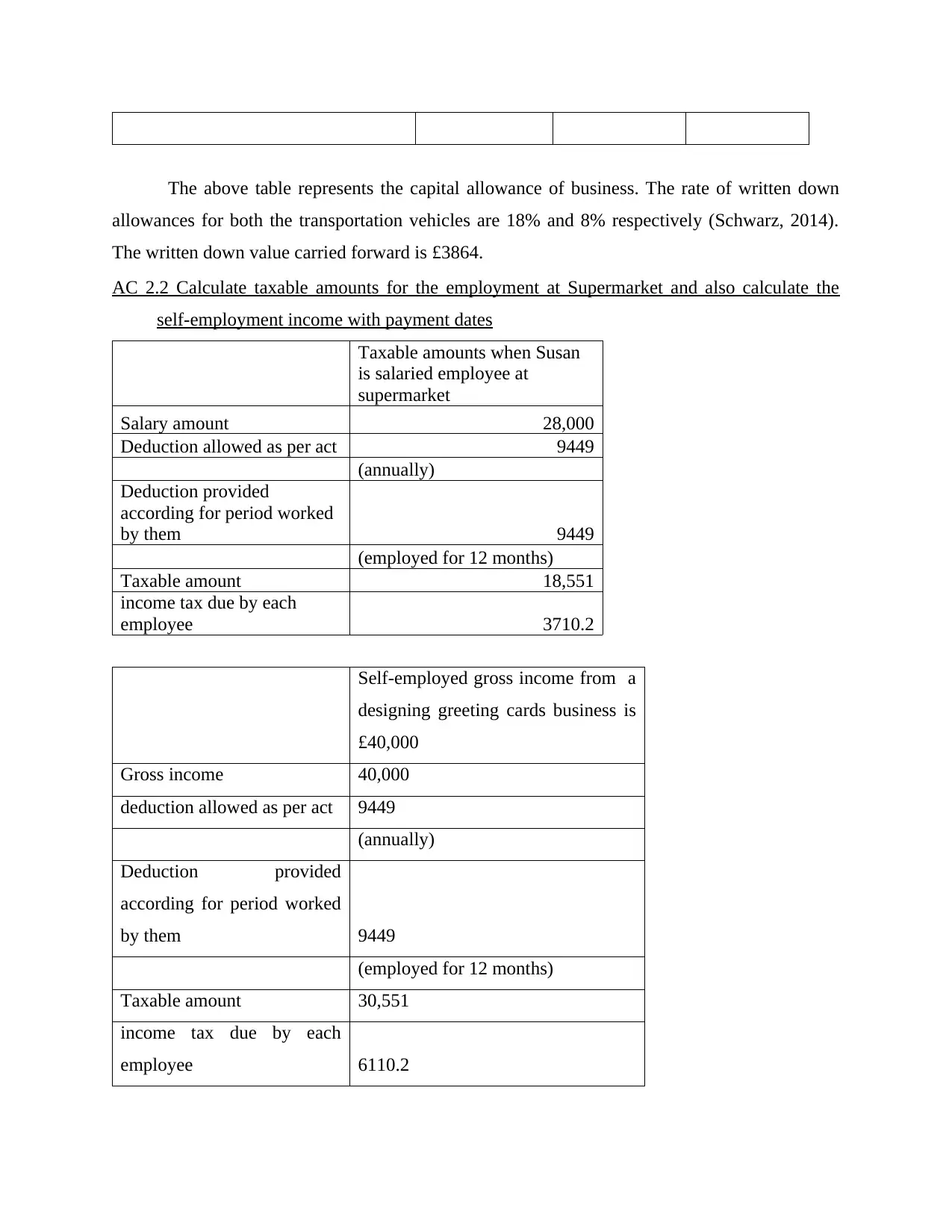
The above table represents the capital allowance of business. The rate of written down
allowances for both the transportation vehicles are 18% and 8% respectively (Schwarz, 2014).
The written down value carried forward is £3864.
AC 2.2 Calculate taxable amounts for the employment at Supermarket and also calculate the
self-employment income with payment dates
Taxable amounts when Susan
is salaried employee at
supermarket
Salary amount 28,000
Deduction allowed as per act 9449
(annually)
Deduction provided
according for period worked
by them 9449
(employed for 12 months)
Taxable amount 18,551
income tax due by each
employee 3710.2
Self-employed gross income from a
designing greeting cards business is
£40,000
Gross income 40,000
deduction allowed as per act 9449
(annually)
Deduction provided
according for period worked
by them 9449
(employed for 12 months)
Taxable amount 30,551
income tax due by each
employee 6110.2
allowances for both the transportation vehicles are 18% and 8% respectively (Schwarz, 2014).
The written down value carried forward is £3864.
AC 2.2 Calculate taxable amounts for the employment at Supermarket and also calculate the
self-employment income with payment dates
Taxable amounts when Susan
is salaried employee at
supermarket
Salary amount 28,000
Deduction allowed as per act 9449
(annually)
Deduction provided
according for period worked
by them 9449
(employed for 12 months)
Taxable amount 18,551
income tax due by each
employee 3710.2
Self-employed gross income from a
designing greeting cards business is
£40,000
Gross income 40,000
deduction allowed as per act 9449
(annually)
Deduction provided
according for period worked
by them 9449
(employed for 12 months)
Taxable amount 30,551
income tax due by each
employee 6110.2
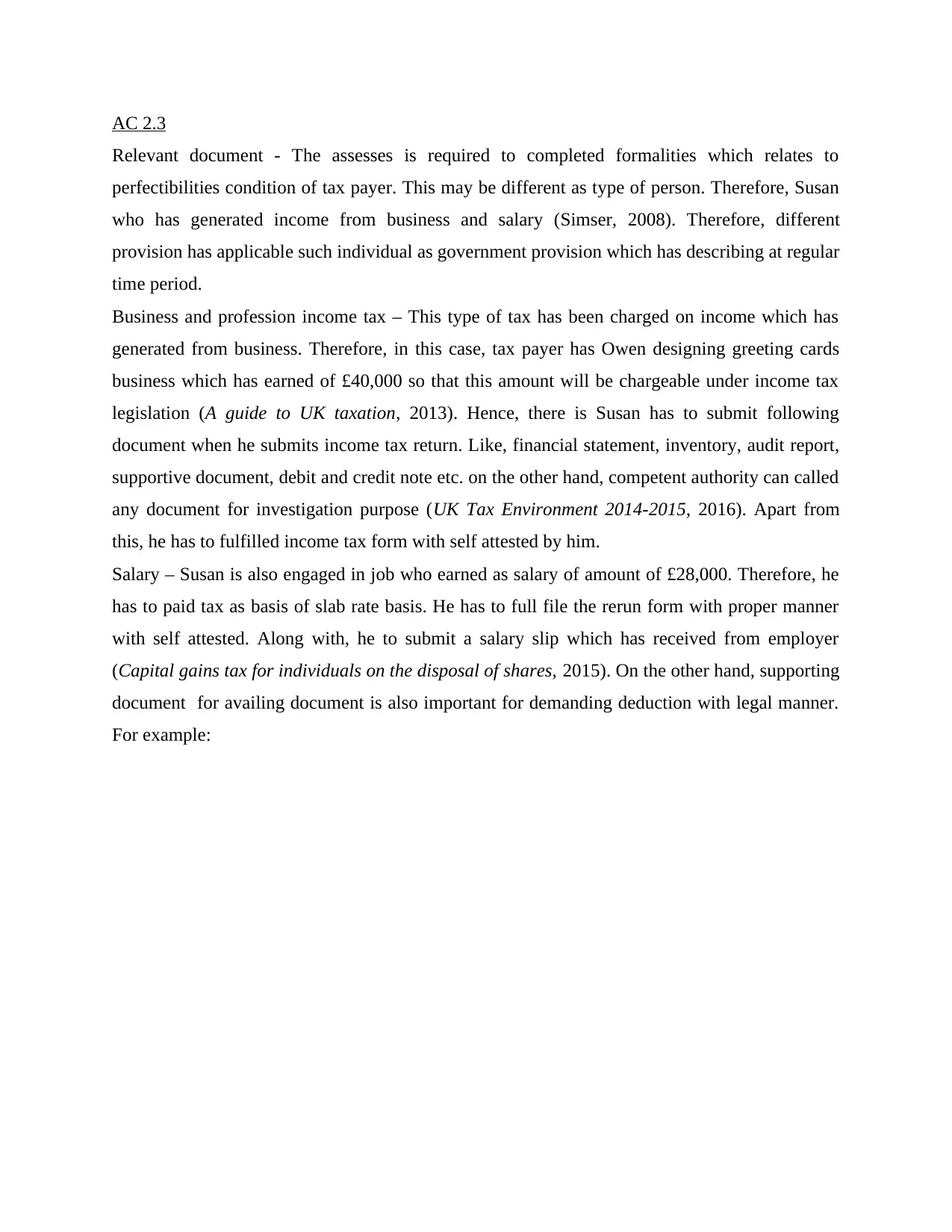
AC 2.3
Relevant document - The assesses is required to completed formalities which relates to
perfectibilities condition of tax payer. This may be different as type of person. Therefore, Susan
who has generated income from business and salary (Simser, 2008). Therefore, different
provision has applicable such individual as government provision which has describing at regular
time period.
Business and profession income tax – This type of tax has been charged on income which has
generated from business. Therefore, in this case, tax payer has Owen designing greeting cards
business which has earned of £40,000 so that this amount will be chargeable under income tax
legislation (A guide to UK taxation, 2013). Hence, there is Susan has to submit following
document when he submits income tax return. Like, financial statement, inventory, audit report,
supportive document, debit and credit note etc. on the other hand, competent authority can called
any document for investigation purpose (UK Tax Environment 2014-2015, 2016). Apart from
this, he has to fulfilled income tax form with self attested by him.
Salary – Susan is also engaged in job who earned as salary of amount of £28,000. Therefore, he
has to paid tax as basis of slab rate basis. He has to full file the rerun form with proper manner
with self attested. Along with, he to submit a salary slip which has received from employer
(Capital gains tax for individuals on the disposal of shares, 2015). On the other hand, supporting
document for availing document is also important for demanding deduction with legal manner.
For example:
Relevant document - The assesses is required to completed formalities which relates to
perfectibilities condition of tax payer. This may be different as type of person. Therefore, Susan
who has generated income from business and salary (Simser, 2008). Therefore, different
provision has applicable such individual as government provision which has describing at regular
time period.
Business and profession income tax – This type of tax has been charged on income which has
generated from business. Therefore, in this case, tax payer has Owen designing greeting cards
business which has earned of £40,000 so that this amount will be chargeable under income tax
legislation (A guide to UK taxation, 2013). Hence, there is Susan has to submit following
document when he submits income tax return. Like, financial statement, inventory, audit report,
supportive document, debit and credit note etc. on the other hand, competent authority can called
any document for investigation purpose (UK Tax Environment 2014-2015, 2016). Apart from
this, he has to fulfilled income tax form with self attested by him.
Salary – Susan is also engaged in job who earned as salary of amount of £28,000. Therefore, he
has to paid tax as basis of slab rate basis. He has to full file the rerun form with proper manner
with self attested. Along with, he to submit a salary slip which has received from employer
(Capital gains tax for individuals on the disposal of shares, 2015). On the other hand, supporting
document for availing document is also important for demanding deduction with legal manner.
For example:
⊘ This is a preview!⊘
Do you want full access?
Subscribe today to unlock all pages.

Trusted by 1+ million students worldwide
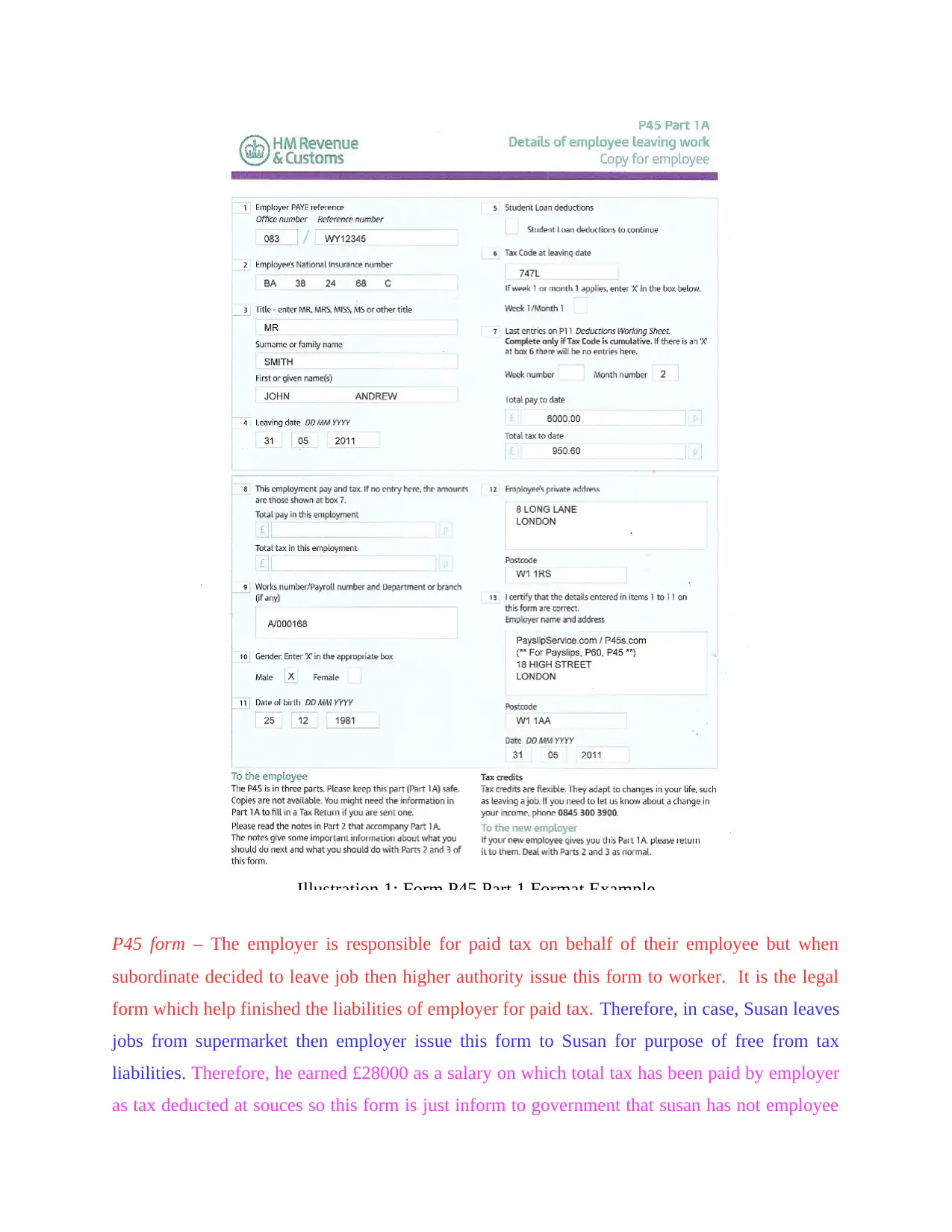
P45 form – The employer is responsible for paid tax on behalf of their employee but when
subordinate decided to leave job then higher authority issue this form to worker. It is the legal
form which help finished the liabilities of employer for paid tax. Therefore, in case, Susan leaves
jobs from supermarket then employer issue this form to Susan for purpose of free from tax
liabilities. Therefore, he earned £28000 as a salary on which total tax has been paid by employer
as tax deducted at souces so this form is just inform to government that susan has not employee
Illustration 1: Form P45 Part 1 Format Example
subordinate decided to leave job then higher authority issue this form to worker. It is the legal
form which help finished the liabilities of employer for paid tax. Therefore, in case, Susan leaves
jobs from supermarket then employer issue this form to Susan for purpose of free from tax
liabilities. Therefore, he earned £28000 as a salary on which total tax has been paid by employer
as tax deducted at souces so this form is just inform to government that susan has not employee
Illustration 1: Form P45 Part 1 Format Example
Paraphrase This Document
Need a fresh take? Get an instant paraphrase of this document with our AI Paraphraser
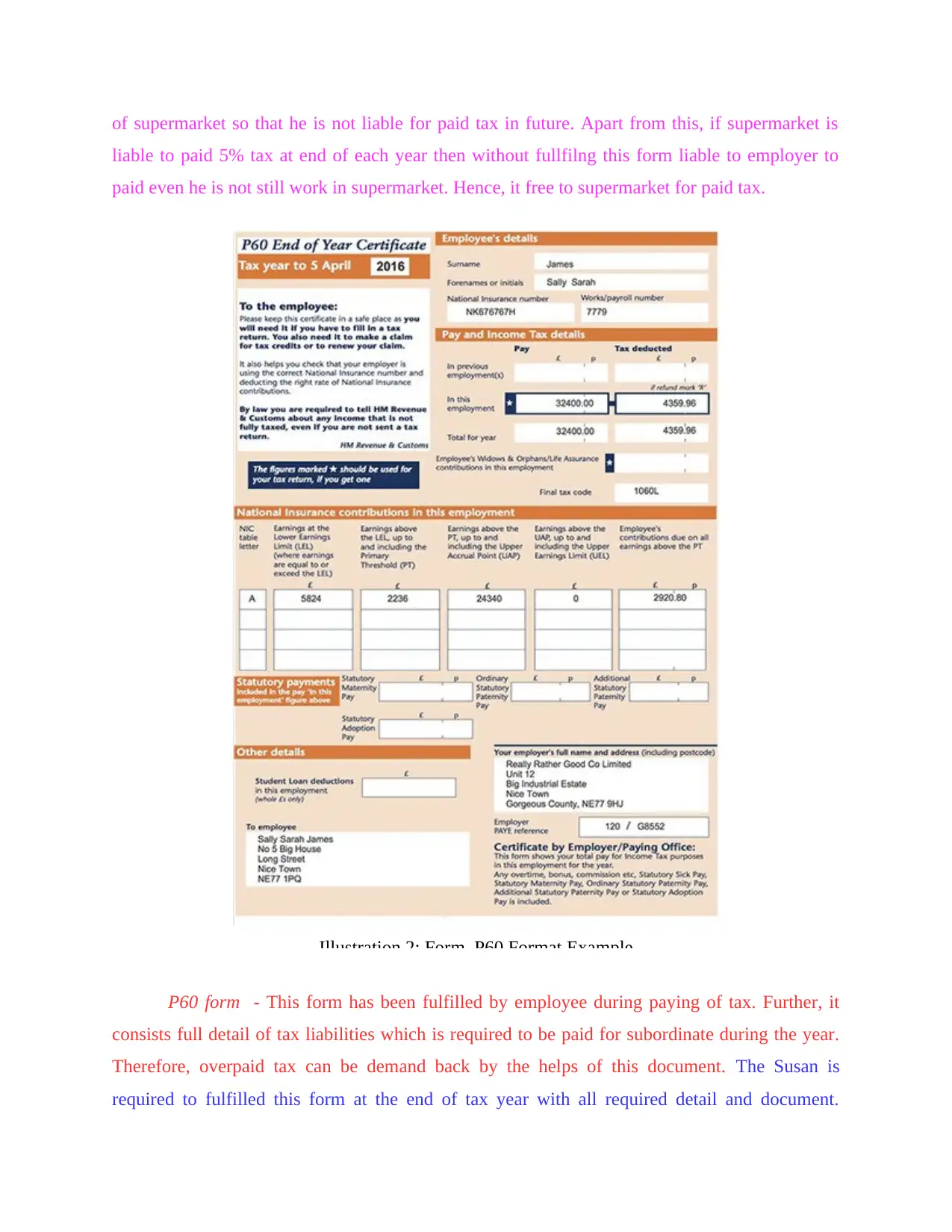
of supermarket so that he is not liable for paid tax in future. Apart from this, if supermarket is
liable to paid 5% tax at end of each year then without fullfilng this form liable to employer to
paid even he is not still work in supermarket. Hence, it free to supermarket for paid tax.
P60 form - This form has been fulfilled by employee during paying of tax. Further, it
consists full detail of tax liabilities which is required to be paid for subordinate during the year.
Therefore, overpaid tax can be demand back by the helps of this document. The Susan is
required to fulfilled this form at the end of tax year with all required detail and document.
Illustration 2: Form P60 Format Example
liable to paid 5% tax at end of each year then without fullfilng this form liable to employer to
paid even he is not still work in supermarket. Hence, it free to supermarket for paid tax.
P60 form - This form has been fulfilled by employee during paying of tax. Further, it
consists full detail of tax liabilities which is required to be paid for subordinate during the year.
Therefore, overpaid tax can be demand back by the helps of this document. The Susan is
required to fulfilled this form at the end of tax year with all required detail and document.
Illustration 2: Form P60 Format Example
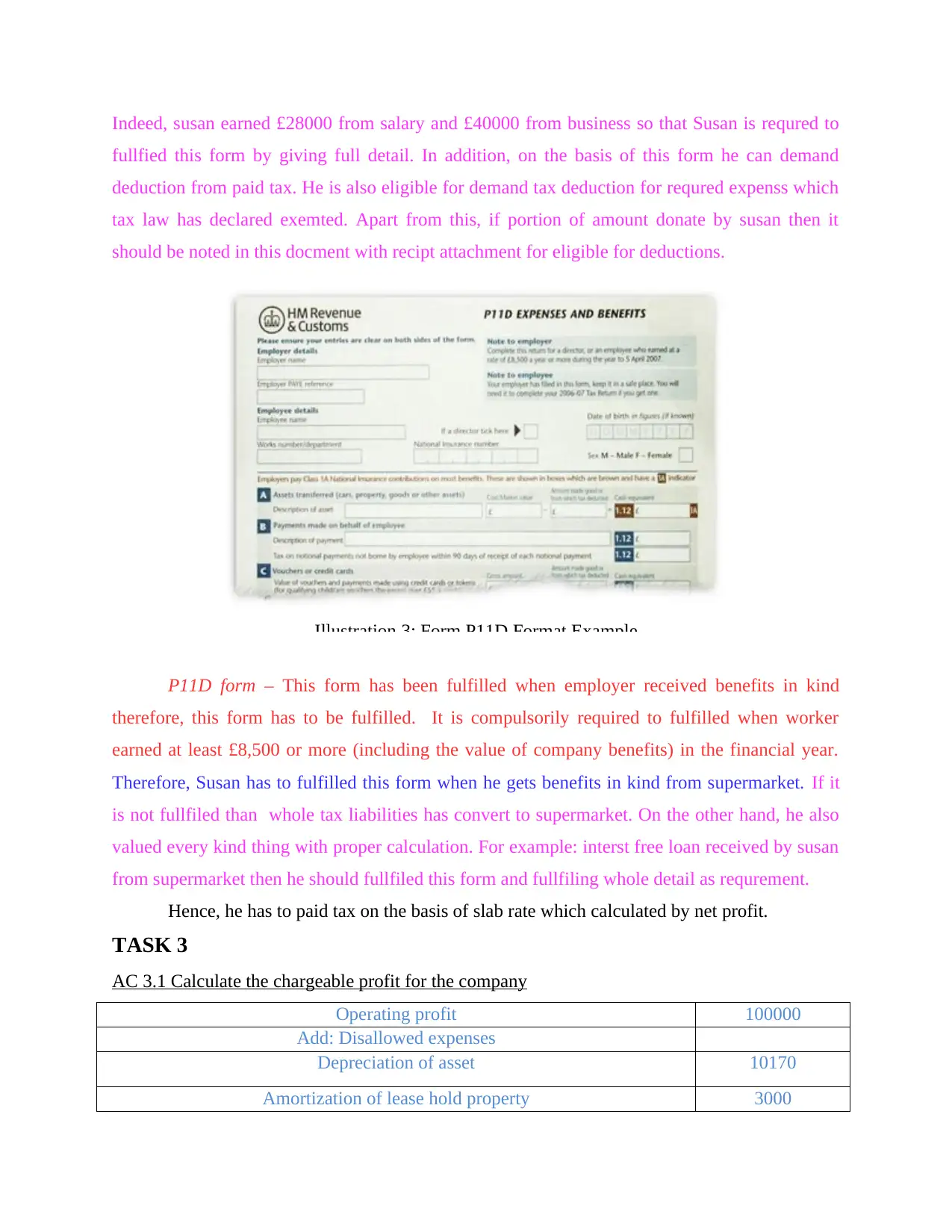
Indeed, susan earned £28000 from salary and £40000 from business so that Susan is requred to
fullfied this form by giving full detail. In addition, on the basis of this form he can demand
deduction from paid tax. He is also eligible for demand tax deduction for requred expenss which
tax law has declared exemted. Apart from this, if portion of amount donate by susan then it
should be noted in this docment with recipt attachment for eligible for deductions.
P11D form – This form has been fulfilled when employer received benefits in kind
therefore, this form has to be fulfilled. It is compulsorily required to fulfilled when worker
earned at least £8,500 or more (including the value of company benefits) in the financial year.
Therefore, Susan has to fulfilled this form when he gets benefits in kind from supermarket. If it
is not fullfiled than whole tax liabilities has convert to supermarket. On the other hand, he also
valued every kind thing with proper calculation. For example: interst free loan received by susan
from supermarket then he should fullfiled this form and fullfiling whole detail as requrement.
Hence, he has to paid tax on the basis of slab rate which calculated by net profit.
TASK 3
AC 3.1 Calculate the chargeable profit for the company
Operating profit 100000
Add: Disallowed expenses
Depreciation of asset 10170
Amortization of lease hold property 3000
Illustration 3: Form P11D Format Example
fullfied this form by giving full detail. In addition, on the basis of this form he can demand
deduction from paid tax. He is also eligible for demand tax deduction for requred expenss which
tax law has declared exemted. Apart from this, if portion of amount donate by susan then it
should be noted in this docment with recipt attachment for eligible for deductions.
P11D form – This form has been fulfilled when employer received benefits in kind
therefore, this form has to be fulfilled. It is compulsorily required to fulfilled when worker
earned at least £8,500 or more (including the value of company benefits) in the financial year.
Therefore, Susan has to fulfilled this form when he gets benefits in kind from supermarket. If it
is not fullfiled than whole tax liabilities has convert to supermarket. On the other hand, he also
valued every kind thing with proper calculation. For example: interst free loan received by susan
from supermarket then he should fullfiled this form and fullfiling whole detail as requrement.
Hence, he has to paid tax on the basis of slab rate which calculated by net profit.
TASK 3
AC 3.1 Calculate the chargeable profit for the company
Operating profit 100000
Add: Disallowed expenses
Depreciation of asset 10170
Amortization of lease hold property 3000
Illustration 3: Form P11D Format Example
⊘ This is a preview!⊘
Do you want full access?
Subscribe today to unlock all pages.

Trusted by 1+ million students worldwide
1 out of 19
Related Documents
Your All-in-One AI-Powered Toolkit for Academic Success.
+13062052269
info@desklib.com
Available 24*7 on WhatsApp / Email
![[object Object]](/_next/static/media/star-bottom.7253800d.svg)
Unlock your academic potential
Copyright © 2020–2025 A2Z Services. All Rights Reserved. Developed and managed by ZUCOL.





